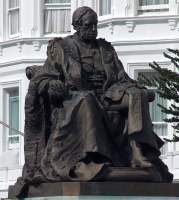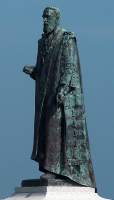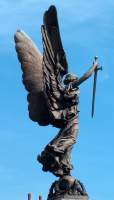 The Seventh Duke of Devonshire, by Goscombe John.
The Seventh Duke of Devonshire, by Goscombe John.
Eastbourne, a seaside town which is along the coast from Hastings and Brighton, has four notable bronze public statues from the period covered by these pages, and some interesting work in the Towner Art Gallery and the church of St Mary the Virgin.
The town was developed as a resort by the William Earl of Burlington, afterwards seventh Duke of Devonshire. The London-Brighton and South Coast Railway was extended to Eastbourne in 1849, the Burlington Hotel was put up there in 1851, and the town was laid out mostly in the 1860s and 1870s. Much of the building was supervised by the civil engineer Ambrose Wallis, agent of the 7th Duke.
 The Seventh Duke of Devonshire, by Goscombe John.
The Seventh Duke of Devonshire, by Goscombe John.
Our first statue, then, is that of the 7th Duke of Devonshire, situated in Devonshire Place, where it meets Grand Parade. It is the work of the prolific sculptor William Goscombe John, and was unveiled in 1901. The Duke is shown seated, wearing the robe of the Chancellor of Cambridge University. A characterful portrait, heavy, a bit careworn, bushy in the eyebrow and with the enlarged ears of age, this is one of Goscombe John's best portraits, to my eye.
Also in Devonshire Place we may note a statue, painted white over probably concrete, of St Luke, a modern work, draped Byzantine-style (see bottom of page).
 The Eighth Duke of Devonshire, by Alfred Drury.
The Eighth Duke of Devonshire, by Alfred Drury.
Our second statue is The 8th Duke of Devonshire, Spencer Compton, who was Mayor of Eastbourne just before the turn of the century, also has a statue in the town, opposite the Grand Hotel by King Edward Parade. The sculptor is Alfred Drury, and the statue was put up in 1910. Again wearing the apparel of Chancellor of Cambridge University - there would seem to have been some degree of hereditariness to the position - the subject is standing, with the hem of the robe angled backwards to emphasise the steeple shape of the composition when viewed in profile.
 Eastbourne War Memorial, by H. C. Fehr.
Eastbourne War Memorial, by H. C. Fehr.
The pick of the public statues is however H. C. Fehrís War Memorial, placed on the roundabout at the end of Devonshire Place. A superb work by one of the masters of New Sculpture, the Angel of Victory stands atop a small globe surrounded with wreaths, wings upraised, as if just descended from on high. In one hand she holds a wreath, in the other a downward pointing sword to make the sign of the cross. Her diaphanous robes, almost a chiton, emphasise the soft curves of her torso and legs; her face is wreathed in the short hair characteristic of 1908, for although this is a work of 1920, it is utterly in the spirit of the art nouveau period. The figure is archetypical, and there are several copies of it across the country - see the Fehr page. Note the little details around the base - winged cherubic heads and spiky dolphins.
For our fourth bronze statue, in Cavendish Place is the Royal Sussex Memorial, a further work by Goscombe John, dating from 1906, with a figure of a soldier, and two plaques below showing soldiers at war.
The Towner Art Gallery has an interesting collection of Victorian art by mainly minor genre painters. John Chisholm Towner (1840-1920) was a local benefactor who, on his death, left a score of paintings from his private collection, and £5000 for building an art gallery, to the people of Eastbourne. In the event, the local council purchased an 18th Century manor house, once the home of the Revd Henry Lushington and his wife, Mary Lushington, and converted this to form the art gallery. It was opened as the Towner Art Gallery in 1923.
The collection includes a bust of a Veiled Lady by Giovanni Battista Lombardi, dating from 1869. This is a well-developed example of a minor Italian genre of sculpture aiming to show thin, diaphanous fabric over face and body, popularised in Britain by Giovanni Fontana.
The paintings of the original Towner Bequest, which have all been on seemingly permanent display when I have visited, include several by well-known artists, including Frederick Goodall, W. J. Mueller, T. S. Cooper, J. F. Herring Sr, Thomas Bush Hardy, David Murray, James Orrock and William Strutt. The local history exhibits include portraits of the Lushingtons, and a room devoted to the war artist Eric Ravilious.
The dark, atmospheric Parish Church contains several minor monuments, most notably a marble bust of Robert Lushington, noted above as original owner of the building which became the Towner Art Gallery. An accomplished work, Classical baroque, attributed to the sculptor Robert Taylor. We may also note the large wall plaque to Katharina Burton, with two little reclining angels, somewhat awkwardly posed, among other decoration, a smaller plaque to a naval hero, William Hector Rason, d 1859, with below, an elegant bust in relief of an angel carrying a shield. Also a monument to James Ranking, d 1827, with a small relief of a ship in full sail (for more ship sculpture, see this page), and a plaque to Revd. Alexander Brodie, Vicar, d1828, with a typical Aladdin-style lamp and other conventional detail. Interesting carving on the pulpit, including a winged lion and a winged bull, thus representing the Apostles, and stained glass, most notably some early 20th century arts and crafts panels with glowing colours.
The pier is a well preserved or restored example of the work of E. Birch, with pavilions with little spiked domes and curved roofs.
The old centre has well preserved Victorian and Edwardian streets, with a main feature being the Town Hall, by the architect W. T. Foulkes, a Queen Anne-style pile with a distinctive tower bearing an onion shaped dome.
Sculpture pages // Sculpture in English towns // Hastings
Visits to this page from 23 Nov 2011: 14,785